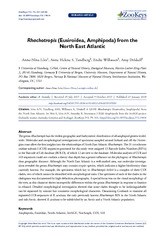| dc.contributor.author | Lörz, Anne-Nina | |
| dc.contributor.author | Tandberg, Anne Helene S. | |
| dc.contributor.author | Willassen, Endre | |
| dc.contributor.author | Driskell, Amy C | |
| dc.date.accessioned | 2018-04-11T11:58:52Z | |
| dc.date.available | 2018-04-11T11:58:52Z | |
| dc.date.issued | 2018 | |
| dc.Published | Lörz A, Tandberg AHS, Willassen E, Driskell AC. Rhachotropis (Eusiroidea, Amphipoda) from the North East Atlantic. Zookeys. 2018;731:75-101 | eng |
| dc.identifier.issn | 1313-2989 | |
| dc.identifier.issn | 1313-2970 | |
| dc.identifier.uri | https://hdl.handle.net/1956/17602 | |
| dc.description.abstract | The genus Rhachotropis has the widest geographic and bathymetric distribution of all amphipod genera worldwide. Molecular and morphological investigations of specimens sampled around Iceland and off the Norwegian coast allow the first insights into the relationships of North East Atlantic Rhachotropis. The 31 cytochrome oxidase subunit I (COI) sequences generated for this study were assigned 13 Barcode Index Numbers (BINs) in the Barcode of Life database (BOLD), of which 12 are new to the database. Molecular analyses of COI and 16S sequences could not confirm a theory that depth has a greater influence on the phylogeny of Rhachotropis than geographic distance. Although the North East Atlantic is a well-studied area, our molecular investigations revealed the genus Rhachotropis may contain cryptic species, which indicates a higher biodiversity than currently known. For example, the specimens which key to Rhachotropis helleri is a complex of three COI clades, two of which cannot be identified with morphological traits. One specimen of each of the clades in the cladogram was documented by high definition photographs. A special focus was on the visual morphology of the eyes, as this character shows interspecific differences within the genus Rhachotropis in response to fixation in ethanol. Detailed morphological investigation showed that some clades thought to be indistinguishable can be separated by minute but consistent morphological characters. Datamining Genbank to examine all registered COI-sequences of R. aculeata, the only previously known Rhachotropis BIN in the North Atlantic and sub-Arctic, showed R. aculeata to be subdivided by an Arctic and a North Atlantic population. | en_US |
| dc.language.iso | eng | eng |
| dc.publisher | Pensoft | eng |
| dc.rights | Attribution CC BY | eng |
| dc.rights.uri | http://creativecommons.org/licenses/by/4.0 | eng |
| dc.subject | Amphipoda | eng |
| dc.subject | Eusiridae | eng |
| dc.subject | North Atlantic | eng |
| dc.subject | IceAGE | eng |
| dc.subject | NorAmph | eng |
| dc.subject | COI | eng |
| dc.subject | 16S | eng |
| dc.title | Rhachotropis (Eusiroidea, Amphipoda) from the North East Atlantic | eng |
| dc.type | Peer reviewed | en_US |
| dc.type | Journal article | en_US |
| dc.date.updated | 2018-01-26T09:48:02Z | |
| dc.description.version | publishedVersion | |
| dc.rights.holder | Copyright 2018 The Author(s) | eng |
| dc.identifier.doi | https://doi.org/10.3897/zookeys.731.19814 | |
| dc.identifier.cristin | 1550376 | |
| dc.source.journal | Zookeys | |
| dc.relation.project | Artsdatabanken: 46-15/70184235 | |

